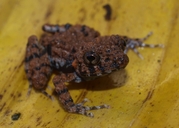|
Description
Originally written for Gephyromantis ventrimaculatus (Miguel Vences and Frank Glaw, first posted 2000-11-30): M 20-23mm, F 24-26 mm. This is a small, broad-headed frog; lectotype measures 30 mm. Dorsum very granular with a reddish brown color. Ventrally black with blue or grey marbling. In preservative brown with dark marks on the legs. Nostrils situated nearer to tip of snout than to eye. Tympanum distinct, tympanum/eye ratio about 1/2. Tibiotarsal articulation reaches between eye and nostril. No webbing. Femoral glands visible but tibial gland absent (Glaw and Vences 2007; see for further references).
Similar species: Gephyromantis horridus has a smaller tympanum. In G. horridus and G. ventrimaculatus the tibiotarsal articulation does not reach beyond tip of snout. G. webbi has webbed feet (Glaw and Vences 2007; see for further references).
Distribution and Habitat
Country distribution from AmphibiaWeb's database: Madagascar
Documented in Ambatovaky, Folohy, Mananara, Masoala, Tampolo, all in Madagascar. Observed at elevations from sea level to 1500m in pristine rainforest, usually on leaves of low vegetation (Glaw and Vallan 2008).
Andasibe, Isaka-Ivondro, Vohiparara. It occurs between 50-1,050m asl in pristine rainforest, living on the forest floor and on low vegetation (Raxworthy and Vallan 2008).
Life History, Abundance, Activity, and Special Behaviors
Habits: The habits and calls of typical G. malagasius from low elevations along the east coast are unknown. Information previously assigned to G. malagasius in fact refers to the following species which is now known to be genetically distinct from east coast populations. Males were observed calling at night in rainforest, close to the ground and more than 10 m away from a stream.
Call (from Andasibe): A single, long, pulsed note. Note duration is 920-1440 ms, one note consists of 26 pulses, pulse repetition rate is 28/s. Calls are regularly repeated after intervals of 750-800 ms (call repetition rate 30/min). Frequency is 2.5-4.5 kHz. Calls from Ankeniheny (23.5°C) are similar: Call repetition rate 26-30/min, pulses per note 18, intervals between pulses 30-80 ms, pulse repetition rate 21/s. Calls from Marojezy are somewhat different: Call repetition rate is lower (15/min), note duration shorter (460 ms), intervals between pulses shorter (21-23 ms), pulse repetition rate higher (42/s; about 20 pulses per note); rarely a very long call was heard (call duration 2000 ms, consisting of about 75 pulses); frequency is 3-4.5 kHz.
Trends and Threats
It occurs in several protected areas, inclduing Réserve Spéciale d’Analamazaotra, Manombo Special Reserve, Parc National de Ranomafana, and Andohahela National Park (Raxworthy and Vallan 2008). Possible reasons for amphibian decline General habitat alteration and loss
Habitat modification from deforestation, or logging related activities
Intensified agriculture or grazing
Urbanization
Habitat fragmentation
Comments
Description and Life History taken with permission from Glaw and Vences (2007).
In an analysis of the Gephyromantis (Laurentomantis) malagasius species complex, Gephyromantis ventrimaculatus became a junior synonym of Gephyromantis malagasius (Vences et al 2022).
References
Glaw, F. and Vallan, D. (2008). Gephyromantis malagasius. In: IUCN 2008. 2008 IUCN Red List of Threatened Species. www.iucnredlist.org. Downloaded on 14 April 2009.
Glaw, F., and Vences, M. (2007). Field Guide to the Amphibians and Reptiles of Madagascar. Third Edition. Vences and Glaw Verlag, Köln.
Vences M, Köhler J, Crottini A, Hofreiter M, Hutter C R, du Preez L, Preick M, Rakotoarison A, Rancilhac L, Raselimanana A P, Rosa G M, Scherz M D, Glaw F (2022). " An integrative taxonomic revision and redefinition of Gephyromantis (Laurentomantis) malagasius based on archival DNA analysis reveals four new mantellid frog species from Madagascar." Vertebrate Zoology, 72, 271–309. [link]
Originally submitted by: Miguel Vences and Frank Glaw (first posted 2000-11-30)
Edited by: Henry Zhu, Michelle S. Koo (2022-06-15)Species Account Citation: AmphibiaWeb 2022 Gephyromantis malagasius <https://amphibiaweb.org/species/4613> University of California, Berkeley, CA, USA. Accessed Jun 6, 2025.
Feedback or comments about this page.
Citation: AmphibiaWeb. 2025. <https://amphibiaweb.org> University of California, Berkeley, CA, USA. Accessed 6 Jun 2025.
AmphibiaWeb's policy on data use.
|
